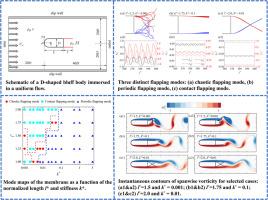Flow control of D-shaped bluff bodies using attached dual membranes
IF 9.4
1区 工程技术
Q1 ENGINEERING, MECHANICAL
International Journal of Mechanical Sciences
Pub Date : 2025-10-02
DOI:10.1016/j.ijmecsci.2025.110910
引用次数: 0
Abstract
In this study, a numerical investigation is conducted on the flow and aerodynamic performance of a d-shaped bluff body passively controlled by two flexible membranes affixed to its trailing. Despite the promise of passive flow control using deformable structures, this specific configuration has received limited attention in prior research. To address this gap, we systematically explore the influence of control parameters, i.e., membrane length and stiffness, on wake dynamics and force characteristics at a Reynolds number of 300. The results reveal that, relative to the uncontrolled bluff body, the integration of rigid membranes leads to notable reduction in both the time-averaged drag coefficient () and the root-mean-square lift coefficient (Cl_rms). Moreover, control effectiveness improves with increasing membrane length, primarily by delaying flow separation and suppressing vortex shedding. Beyond rigid configurations, membranes with optimized flexibility exhibit even greater aerodynamic benefits, arising from qualitatively different fluid–structure interaction mechanisms that depend on the dynamic flapping behavior of the membranes. Within the explored parameter space, three distinct flapping modes are identified: chaotic flapping, contact flapping, and periodic flapping. Each mode exhibits characteristic kinematic behaviors and aerodynamic responses that significantly affect flow control performance. Among them, the contact flapping mode-defined by contact between two filaments yields the optimal performance gains locally, achieving a 23.0 % decrease in and a 92.6 % decrease in Cl_rms at a non-dimensional membrane length of l* = 2.0 and bending stiffness of k* = 0.01. The periodic flapping mode, characterized by sustained and regular flapping motion without filament contact, also demonstrates considerable performance improvements, achieving a 17.3 % reduction in and a 53.8 % reduction in Cl_rms at l* = 1.75 and k* = 0.1. To elucidate the underlying mechanisms, a detailed investigation of the flow structures, pressure fields, membrane kinematics, and aerodynamic force components is conducted. This study provides the first systematic mapping and analysis of three distinct flapping modes in a d-shaped bluff body with dual membranes, establishing clear correlations with aerodynamic forces and flow structures. The insights gained from this study may enhance the understanding of fluid-structure interaction in passive flow control and offer valuable guidelines for aerodynamic optimization in related engineering applications.

附著双膜的d型钝体流动控制
本文采用数值模拟的方法,研究了附着在尾翼上的柔性膜被动控制的d型钝体的流动和气动性能。尽管使用可变形结构的被动流动控制有希望,但这种特定的配置在先前的研究中受到的关注有限。为了解决这一差距,我们系统地探索了控制参数(即膜长度和刚度)对雷诺数为300时尾迹动力学和力特性的影响。结果表明,相对于不受控制的钝体,刚性膜的整合导致时间平均阻力系数(Cd)和均方根升力系数(Cl_rms)的显著减少。此外,随着膜长度的增加,控制效果提高,主要是通过延迟流动分离和抑制涡流脱落来实现的。除了刚性结构外,柔性优化的膜还具有更大的空气动力学优势,这是由于依赖于膜的动态扑动行为的质性不同的流固相互作用机制所产生的。在探索的参数空间内,识别出三种不同的扑动模式:混沌扑动、接触扑动和周期扑动。每种模式都表现出独特的运动学行为和空气动力学响应,显著影响流动控制性能。其中,由两根丝之间的接触定义的接触扑动模式在局部获得了最佳的性能增益,在无因次膜长度为l* = 2.0,弯曲刚度为k* = 0.01时,Cd形式减少23.0%,Cl_rms减少92.6%。周期性拍打模式,其特点是持续和规则的拍打运动,没有细丝接触,也显示出相当大的性能改进,在l* = 1.75和k* = 0.1时,Cd的形式减少17.3%,Cl_rms减少53.8%。为了阐明潜在的机制,对流动结构、压力场、膜运动学和气动力成分进行了详细的研究。本研究首次系统地绘制和分析了双膜d型钝体中三种不同的扑动模式,建立了气动力和流动结构之间的明确关联。本文的研究成果有助于提高对被动流动控制中流固耦合问题的认识,并为相关工程应用中的气动优化提供有价值的指导。
本文章由计算机程序翻译,如有差异,请以英文原文为准。
求助全文
约1分钟内获得全文
求助全文
来源期刊

International Journal of Mechanical Sciences
工程技术-工程:机械
CiteScore
12.80
自引率
17.80%
发文量
769
审稿时长
19 days
期刊介绍:
The International Journal of Mechanical Sciences (IJMS) serves as a global platform for the publication and dissemination of original research that contributes to a deeper scientific understanding of the fundamental disciplines within mechanical, civil, and material engineering.
The primary focus of IJMS is to showcase innovative and ground-breaking work that utilizes analytical and computational modeling techniques, such as Finite Element Method (FEM), Boundary Element Method (BEM), and mesh-free methods, among others. These modeling methods are applied to diverse fields including rigid-body mechanics (e.g., dynamics, vibration, stability), structural mechanics, metal forming, advanced materials (e.g., metals, composites, cellular, smart) behavior and applications, impact mechanics, strain localization, and other nonlinear effects (e.g., large deflections, plasticity, fracture).
Additionally, IJMS covers the realms of fluid mechanics (both external and internal flows), tribology, thermodynamics, and materials processing. These subjects collectively form the core of the journal's content.
In summary, IJMS provides a prestigious platform for researchers to present their original contributions, shedding light on analytical and computational modeling methods in various areas of mechanical engineering, as well as exploring the behavior and application of advanced materials, fluid mechanics, thermodynamics, and materials processing.
 求助内容:
求助内容: 应助结果提醒方式:
应助结果提醒方式:


